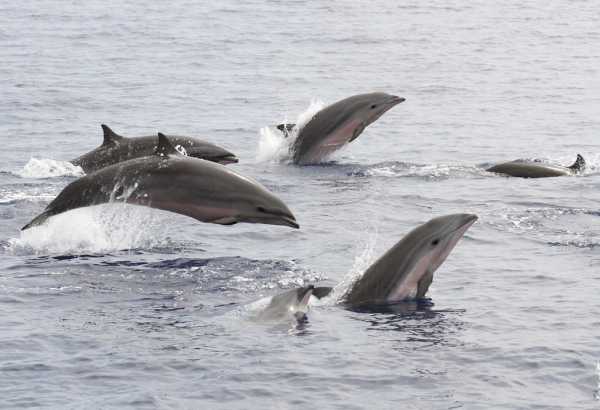Lagenodelphis hosei
IUCN
LCBasic Information
Scientific classification
- name:Lagenodelphis hosei
- Scientific Name:Lagenodelphis hosei,Fraser's Dolphin,Hourglass dolphin, Freund's dolphin, Freund's dolphin
- Outline:Cetacea
- Family:Odontoceti Delphinidae
Vital signs
- length:180-230cm
- Weight:130kg
- lifetime:25-35years
Feature
Its appearance is similar to that of the blue-and-white dolphin and the long-beaked dolphin.
Distribution and Habitat
Pan-tropical distribution, roughly between 30 degrees north latitude and 30 degrees south latitude in the Atlantic, Indian and Pacific Oceans. Including the Philippines in the tropical Pacific Ocean, northern Australia, the eastern tropical Pacific equatorial waters and the Caribbean Sea in the Atlantic Ocean; Sri Lanka, Indonesia and South African waters in the northern Indian Ocean have also been found, and there are also distributions in the East China Sea and the South China Sea, and it has been caught many times in Taiwan Province.
Main distribution countries and regions: Angola, Argentina, Australia, Brazil, Brunei Darussalam, Cape Verde, China, Colombia, Comoros, Cook Islands, Costa Rica, Dominican Republic, Ecuador, French Polynesia, Ghana, Indonesia, Japan, Kenya, Kiribati, Madagascar, Malaysia, Maldives, Mayotte, Micronesia, Nauru, Oman, Palau, Panama, Papua New Guinea, Philippines, Puerto Rico, Reunion, Saint Vincent and the Grenadines, Samoa, Senegal, Solomon Islands, So
Appearance
The body length is generally 180-230 cm. The appearance and skull are intermediate between the Pacific white-faced dolphin and the true dolphin. The snout is short, accounting for only 1.1%-2.1% of the body length. The head is not bulging, and it rises gently from the junction of the snout and forehead to the highest point of the head, the blowhole. The mouth is about 1/10 of the body length. The eyes are located above the corners of the mouth, 4-6 cm apart. The blowhole is above the eye section of the top of the head and is about 2.5 cm wide. The dorsal fin is triangular, the flippers are small, and the caudal fin is also small. The back of the body is blue-gray or brown, and the ventral side is white. The dorsal fin, flippers, and caudal fin are all black.
Details
The Sarawak dolphin is called Fraser's Dolphin in foreign language, and there is no subspecies.

The Sarawak dolphin is a tropical, offshore species, and it usually swims in groups of dozens to hundreds of individuals, and even in large groups of thousands of individuals. They often swim with spotted dolphins, melon-headed whales and pilot whales. In tropical waters, they often swim with blue-white dolphins and long-beaked dolphins. Because of their similar appearance to blue-white dolphins and long-beaked dolphins, it is difficult to identify them at a long distance at sea.
Sarawak dolphins often dive to 250-500 meters underwater to prey on mid-layer species in the ocean. Their main prey is various fish; their stomachs contain the remains of fish, shrimp, crustaceans and squid. The natural enemies of Sarawak dolphins have not yet been discovered, but killer whales, false killer whales and sharks occasionally take them as prey.
Both sexes of Sarawak dolphins mature at around 7 years old. Mature females are 2.25 to 2.35 meters long. Except for body size and dorsal fin shape, there are no other sexual dimorphisms. They can give birth all year round, with the peak calving season in the summer. The gestation period is 11 months, and the newborn dolphins are about 110 cm long. The birth interval is 2 years.
There is a strong and stable relationship between Sarawak dolphins and melon-headed whales. In most cases, melon-headed whales often surround or follow Sarawak dolphin groups.
The abundance of Sarawak dolphins has only been counted in a few areas. There are about 289,500 living in the tropical waters of the eastern Pacific Ocean. In the East Sulu Sea, according to a 2006 survey, there are about 13,500. In 2002, the transect method was used to measure the population size of the entire Hawaiian waters during navigation, and the results showed that there were 10,226 Sarawak dolphins living in the local waters.
Sarawak dolphins are caught in small quantities in dolphin fisheries off the coasts of Indonesia, Sri Lanka and Japan, and are also caught in tuna purse seine fisheries in the tropical waters of the eastern Pacific. In the 1970s, 16 were caught in Philippine waters and sent to the Hong Kong Aquarium for breeding. Ten of them were kept for more than three weeks, and the last one died after 100 days of breeding. However, in China, the specific amount of resources is still unclear.
Listed in Appendix II of the Convention on the Conservation of Migratory Species of Wild Animals (CMS).
Listed in Appendix II of the Convention on International Trade in Endangered Species of Wild Fauna and Flora (CITES).
Listed in the 2012 Red List of Threatened Species of the World Conservation Union (IUCN) ver 3.1 - Least Concern (LC).
Listed in the Red List of Chinese Species - Vulnerable (VU).
Listed in the second level of the List of Wildlife under State Protection in China.
Protect wildlife and stop eating game.
Maintaining ecological balance is everyone's responsibility!








